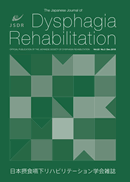Volume 10, Issue 3
The Japanese Journal of Dysphagia Rehabilitation
Displaying 1-10 of 10 articles from this issue
- |<
- <
- 1
- >
- >|
Review Article
-
2006Volume 10Issue 3 Pages 193-206
Published: December 31, 2006
Released on J-STAGE: January 10, 2021
Download PDF (4759K) -
2006Volume 10Issue 3 Pages 207-219
Published: December 31, 2006
Released on J-STAGE: January 10, 2021
Download PDF (3062K)
Original Paper
-
2006Volume 10Issue 3 Pages 220-230
Published: December 31, 2006
Released on J-STAGE: January 10, 2021
Download PDF (3447K) -
Study on a Simple Method of Assessing Masticatory Function based on the Number of Masticatory Cycles2006Volume 10Issue 3 Pages 231-238
Published: December 31, 2006
Released on J-STAGE: January 10, 2021
Download PDF (2422K) -
2006Volume 10Issue 3 Pages 239-248
Published: December 31, 2006
Released on J-STAGE: January 10, 2021
Download PDF (3164K) -
2006Volume 10Issue 3 Pages 249-256
Published: December 31, 2006
Released on J-STAGE: January 10, 2021
Download PDF (2348K) -
2006Volume 10Issue 3 Pages 257-267
Published: December 31, 2006
Released on J-STAGE: January 10, 2021
Download PDF (3613K)
Clinical Report
-
2006Volume 10Issue 3 Pages 268-273
Published: December 31, 2006
Released on J-STAGE: January 10, 2021
Download PDF (1915K) -
2006Volume 10Issue 3 Pages 274-281
Published: December 31, 2006
Released on J-STAGE: January 10, 2021
Download PDF (2460K)
Short Communication
-
2006Volume 10Issue 3 Pages 282-287
Published: December 31, 2006
Released on J-STAGE: January 10, 2021
Download PDF (1808K)
- |<
- <
- 1
- >
- >|
